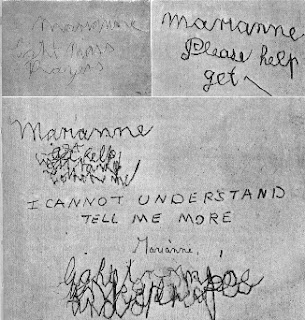Leap Castle
Standing upon a vast throne of solid rock, Leap Castle is an Irish castle it was built in the late 15th century by the O'Bannon family and was originally called "Leap of the O'Bannons." The O'Bannons were the "secondary chieftains" of the territory, and were subject to the ruling of the warlike O'Carroll clan.
The Earl of Kildare, Gerald FitzGerald, tried unsuccessfully to seize the castle in 1513-14. Three years later, he attacked the castle again and managed to partially demolish it. However, by 1557 the O'Carrolls had regained possession. In 1558 the castle was deliberately set on fire and ruined to prevent it being captured by Elizabethan forces, who decided to occupy the castle anyway. It was recaptured by the O’Carrolls less than a year later.
 |
| The ruined section of Leap Castle - inside view |
Following the death of Mulrooney O' Carroll in 1532, family struggles plagued the O'Carroll clan. A fierce rivalry for the leadership erupted within the family. The bitter fight for power turned brother against brother. One of the brothers was a priest. The O'Carroll priest was holding mass for a group of his family (in what is now called the "Bloody Chapel"). While he was chanting the holy rites, his rival brother burst into the chapel, plunged his sword into his brother and fatally wounded him. The butchered priest fell across the altar and died in front of his family.
In 1659, the castle passed by marriage into the ownership of the Darby family. The castle was altered during the 17th century. They extended the castle and added the Jacobean house to the N face of the tower house. A later Georgian house was also added. However in order to pay for these extensions, rents were raised and much of the land accompanying the castle was sold. The castle was finally destroyed by 30 bombs and 20 cases of petrol in 1922 during the civil war.
Many people were imprisoned and executed in the castle, and it is supposedly haunted by several specters the most terrifying of these beings is a small grey humanoid with a decaying face with black holes for eyes. The apparition is said to be accompanied by the stench of a decomposing corpse and the smell of sulphur. Some call this an Elemental and its name is 'It!'
 |
| The ruined section of Leap Castle -outside view |
One account from the 17th century from Mrs. Jonathan Darby and her alleged encounter with a type of ghost called an “elemental”. It runs as follows:
“The thing was about the size of a sheep, thin, gaunt and shadow in parts. Its face was human, or to be more accurate, inhuman, in its vileness, with large holes of blackness for eyes, loose slobbery lips, and a thick saliva dripping jaw, sloping back suddenly into its neck. Nose it had none, only spreading cancerous cavities, the whole face being a uniform tint of grey. This too was the colour of the dark coarse hair covering its head, neck and body. Its fore arms were thickly coated with the same hair, so were its paws, large loose and hand-shaped and as it sat on its hind legs, one hand or paw was raised, and a claw like finger was extended ready to scratch the paint. Its lusterless eyes, which seemed half decomposed in black cavities, and looked incredibly foul, stared into mine, and the horrible smell which had before offended my nostrils, only a hundred times intensified, came up into my face, filling me with a deadly nausea. I noticed the lower half of the creature was indefinite and seemed semi-transparent at least, I could see the framework of the door that led into the gallery through its body.”
 |
| The Bloody Chapel |
While renovating a hidden dungeon was found off the bloody chapel. It was a small room with a drop floor. Those who were forgotten within this room suffered unimaginable pain and misery until their death. Prisoners would be pushed into the room to fall through the floor and land on a spike eight feet below. If you were not lucky enough to die quickly on the spike, you died of starvation in an odorless room while the aroma of food and the sounds of merriment drifted up from the rooms below. A narrow window would let you watch those who came and went in freedom from the castle.
The castle workers discovered human skeletons laid piled on top of each other. It took three full cart loads to remove all of the bones. Among the bones workmen found a pocket watch made in the 1840's it is unknown who it belonged to. It is not certain if the dungeon was still in use then. These series of spikes are now covered with a vast amount of twigs, grass and dirt, to protect anyone entering it.
 |
| The Oubliette |
However in May 2002 Sean Ryan, , found a ghostly old man sitting in a chair by a downstairs fireplace. Having bade his phantom guest “good day”, Sean continued about his business. After all, a new ghost dropping by unannounced, is just part of life’s rich tapestry, when you happen to live in what has long been considered Ireland’s most haunted castle.

























